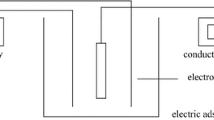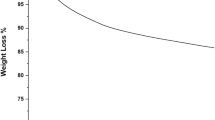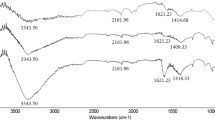Abstract
TiO2-impregnated activated carbon was designed to adsorb and remove arsenic from water polluted by diphenylchloroarsine. The material showed an excellent efficiency to treat the contaminated water with diphenylchloroarsine perhaps because TiO2 and activated carbon have a collaborative removal of arsenic to adsorb diphenylchloroarsine and its hydrolysis product. In our study, several important factors on arsenic removal efficiency were evaluated including the adsorption time, initial concentration of arsenic, temperature and pH. The TiO2-impregnated activated carbon can achieve a good performance when it treats DA-contaminated water with the arsenic concentrations below 10 mg/mL in 1 h at pH of 7 and at the temperature ranging from 10 to 40 °C. A combination of FTIR, Brunauer–Emmett–Teller and energy-dispersive spectroscopy analyses further enables identification of the arsenic on the surfaces of TiO2-impregnated activated carbon. Therefore, the TiO2-impregnated activated carbon holds a promising prospect to deal with the polluted water caused by DA, one of chemical weapons abandoned by Japanese in China.







Similar content being viewed by others
Data availability
The authors can confirm that all relevant data are included in the article.
References
Alka S, Shahir S, Ibrahim N, Ndejiko MJ, Vo D-VN, Manan FA (2021) Arsenic removal technologies and future trends: a mini review. J Clean Prod 278:123805
Altowayti WAH, Othman N, Shahir S, Alshalif AF, Al-Gheethi AA, Al-Towayti FAH, Saleh ZM, Haris SA (2022) Removal of arsenic from wastewater by using different technologies and adsorbents: a review. Int J Environ Sci Te 19:9243
Arao T, Maejima Y, Baba K (2009) Uptake of aromatic arsenicals from soil contaminated with diphenylarsinic acid by rice. Environ Sci Technol 43:1097
Arao T, Maejima Y, Baba K (2011) Reduction in uptake by rice and soybean of aromatic arsenicals from diphenylarsinic acid contaminated soil amended with activated charcoal. Environ Pollut 159:2449
Ashraf S, Siddiqa A, Shahida S, Qaisar S (2019) Titanium-based nanocomposite materials for arsenic removal from water: a review. Heliyon 5:e01577
Atulba SLS, Jang JH, Park M (2019) TiO2-pillared magadiite and its arsenic adsorption capacity. J Porous Mat 26:311
Carneiro MA, Pintor AMA, Boaventura RAR, Botelho CMS (2021) Current trends of arsenic adsorption in continuous mode: literature review and future perspectives. Sustain Basel 13(3):1186
Chen WF, Parette R, Cannon FS (2008) Arsenic adsorption via iron-preloaded activated carbon and zero-valent iron. J Am Water Works Ass 100:96
Eom H, Jang Y, Kim SS (2019) Various metal oxide additions based on TiO2 and adsorption characteristics of hollow fiber adsorbent on arsenic. Appl Chem Eng 30:345
Gao WL (2017) Unearthing poison: disposal of abandoned chemical weapons in China. B Atom Sci 73:404
Gong XJ, Li YS, Dong YQ, Li WG (2020) Arsenic adsorption by innovative iron/calcium in-situ-impregnated mesoporous activated carbons from low-temperature water and effects of the presence of humic acids. Chemosphere 250:126275
Guan XH, Du JS, Meng XG, Sun YK, Sun B, Hu QH (2012) Application of titanium dioxide in arsenic removal from water: a review. J Hazard Mater 221:303
Ha HT, Phong PT, Minh TD (2021) Synthesis of iron oxide nanoparticle functionalized activated carbon and its applications in arsenic adsorption. J Anal Methods Chem 2021:1–9
Hotze EM, Phenrat T, Lowry GV (2010) Nanoparticle aggregation: challenges to understanding transport and reactivity in the environment. J Environ Qual 39:1909
Hu S, Shi QT, Jing CY (2015) Groundwater arsenic adsorption on granular TiO2: integrating atomic structure filtration, and health impact. Environ Sci Technol 49:9707
Hua M, Zhang SJ, Pan BC, Zhang WM, Lv L, Zhang QX (2012) Heavy metal removal from water/wastewater by nanosized metal oxides: a review. J Hazard Mater 211:317
Jing CY and Yan L (2016) TiO2 facets determine arsenic adsorption and photo-oxidation. Abstr Pap Am Chem S 252
Joshi S, Sharma M, Kumari A, Shrestha S, Shrestha B (2019) Arsenic removal from water by adsorption onto iron oxide/nano-porous carbon magnetic composite. Appl Sci-Basel 9(18):3732
Koohzad E, Jafari D, Esmaeili H (2019) Adsorption of lead and arsenic ions from aqueous solution by activated carbon prepared from tamarix leaves. ChemistrySelect 4:12356
Lee SH, Jang YH, Nguyen DD, Chang SW, Kim SC, Lee SM, Kim SS (2019) Adsorption properties of arsenic on sulfated TiO2 adsorbents. J Ind Eng Chem 80:444
Liu H, Zuo KC and Vecitis C (2015) Arsenic adsorption in highly dispersed conductive TiO2-CNT nanosystems: Enhanced sorption behavior due to mass transport, electrosorption, and adsorbent dispersion. Abstr Pap Am Chem S 249
Minovic TZ, Gulicovski JJ, Stoiljkovic MM, Jokic BM, Zivkovic LS, Matovic BZ, Babic BM (2015) Surface characterization of mesoporous carbon cryogel and its application in arsenic (III) adsorption from aqueous solutions. Micropor Mesopor Mat 201:271
Mondal MK, Garg R (2017) A comprehensive review on removal of arsenic using activated carbon prepared from easily available waste materials. Environ Sci Pollut R 24:13295
Nabi D, Aslam I, Qazi IA (2009) Evaluation of the adsorption potential of titanium dioxide nanoparticles for arsenic removal. J Environ Sci-China 21:402
Nazari A, Nakhaei M, Yari AR (2021) Arsenic adsorption by TiO2 nanoparticles under conditions similar to groundwater: batch and column studies. Int J Environ Res 15:79
Nicomel NR, Leus K, Folens K, Van der Voort P, Du Laing G (2016) Technologies for arsenic removal from water: current status and future perspectives. Int J Env Res Pub He 13(1):62
Nieto-Delgado C, Gutierrez-Martinez J, Rangel-Mendez JR (2019) Modified activated carbon with interconnected fibrils of iron-oxyhydroxides using Mn2+ as morphology regulator, for a superior arsenic removal from water. J Environ Sci-China 76:403
Rahman HL, Erdem H, Sahin M, Erdem M (2020) Iron-incorporated activated carbon synthesis from biomass mixture for enhanced arsenic adsorption. Water Air Soil Poll 231:1–17
Ranjan S, Yadav BK, Joshi H (2022) Removal of arsenic (III and V) from aqueous solution using stable maghemite (γ-Fe2O3) loaded pumice composite. Int J Environ Sci Te 19:4737
Rosales M, Orive J, Espinoza-Gonzalez R, de Luis RF, Gauvin R, Brodusch N, Rodriguez B, Gracia F, Garcia A (2021) Evaluating the bi-functional capacity for arsenic photo-oxidation and adsorption on anatase TiO2 nanostructures with tunable morphology. Chem Eng J 415:128906
Tang YC, Wu CN, Huang XH, Zhang HP, Yu HQ, Li X, Peng Y (2012) Arsenic(III) removal from low-arsenic water by adsorption with amorphous mesoporous TiO2. Desalin Water Treat 49:359
Tu AT (2011) Chemical weapons abandoned by the imperial Japanese army in Japan and China at the end of world war II. Toxin Rev 30:1
Vadahanambi S, Lee SH, Kim WJ, Oh IK (2013) Arsenic removal from contaminated water using three-dimensional graphene-carbon nanotube-iron oxide nanostructures. Environ Sci Technol 47:10510
Van Vinh N, Zafar M, Behera SK, Park HS (2015) Arsenic(III) removal from aqueous solution by raw and zinc-loaded pine cone biochar: equilibrium, kinetics, and thermodynamics studies. Int J Environ Sci Te 12:1283
Wang AA, Li SX, Teng Y, Liu WX, Wu LH, Zhang HB, Huang YJ, Luo YM, Christie P (2013) Adsorption and desorption characteristics of diphenylarsenicals in two contrasting soils. J Environ Sci-China 25:1172
Wang AN, Teng Y, Luo YM (2014) Photo-catalytical degradation of diphenylarsinic acid by TiO2 (P25). Huan Jing Ke Xue 35:3800
Xiong Y, Tong Q, Shan WJ, Xing ZQ, Wang YJ, Wen SQ, Lou ZN (2017) Arsenic transformation and adsorption by iron hydroxide/manganese dioxide doped straw activated carbon. Appl Surf Sci 416:618
Xu TL, Cai Y, O’Shea KE (2007) Adsorption and photocatalyzed oxidation of methylated arsenic species in TiO2 suspensions. Environ Sci Technol 41:5471
Yao SH, Liu ZR, Shi ZL (2014) Arsenic removal from aqueous solutions by adsorption onto iron oxide/activated carbon magnetic composite. J Environ Health Sci 12:1–8
Zhu M, Hu X, Tu C, Zhang H, Song F, Luo Y, Christie P (2019) Sorption mechanisms of diphenylarsinic acid on ferrihydrite, goethite and hematite using sequential extraction FTIR measurement and XAFS spectroscopy. Sci Total Environ 669:991
Zhu HJ, Shi MY, Zhang XJ, Liu B, Yao DH (2020) Adsorption kinetics of arsenic (V) on nanoscale zero-valent iron supported by activated carbon. Nanomaterials-Basel 10(9):1791
Author information
Authors and Affiliations
Corresponding author
Ethics declarations
Conflict of interest
There are no conflicts to declare.
Additional information
Editorial responsibility: T. Karak.
Supplementary Information
Below is the link to the electronic supplementary material.
Rights and permissions
Springer Nature or its licensor (e.g. a society or other partner) holds exclusive rights to this article under a publishing agreement with the author(s) or other rightsholder(s); author self-archiving of the accepted manuscript version of this article is solely governed by the terms of such publishing agreement and applicable law.
About this article
Cite this article
Wang, X., Zhang, L., Zhou, H. et al. TiO2-impregnated activated carbon for removal of arsenic from water polluted by diphenylchloroarsine. Int. J. Environ. Sci. Technol. 20, 12397–12404 (2023). https://doi.org/10.1007/s13762-023-04820-0
Received:
Revised:
Accepted:
Published:
Issue Date:
DOI: https://doi.org/10.1007/s13762-023-04820-0




